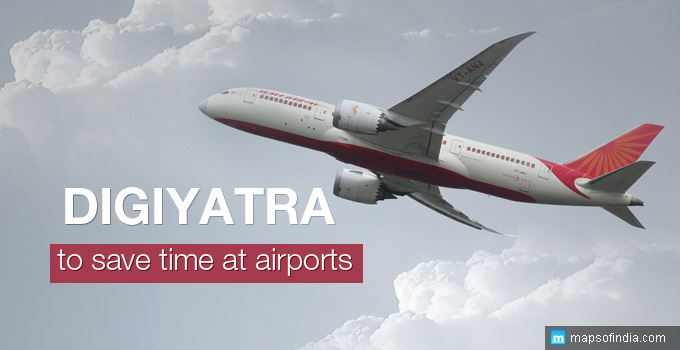The Government of India has announced the launch of “Digiyatra” to give a digital travel experience to the Indian flyers. Minister of State for Civil Aviation Jayant Sinha today launched the report on ‘DigiYatra’. ‘DigiYatra’ is an industry-led initiative. It is being co-ordinated by the Ministry in line with Prime Minister Narendra Modi’s Digital India vision to transform the nation into a digitally-empowered society. In line with the introduction of “Digiyatra”, the government is going to make unique identification such as Aadhaar, passport or PAN mandatory for booking flight tickets.
The plan comes close on the heels of AirSewa, a digital platform to lodge complaints against stakeholders in the aviation sector.
As per plans, the “Digiyatra” scheme will link the Unique Ids such as Aadhaar, passport or PAN card of the Indian citizens to the airlines’ booking PNR. The automated system will link unique identification (UID) with air tickets at the time of booking. It will then work as a digital boarding pass, which can further be used at all the points at an airport through smart phones. This will help a seamless travel experience for the flyers and help give relief to the queues and congestions that have become a norm at airports across India.
The Advantages of Digiyatra
- Check-in and boarding time at airports may halve by the end of the year.
- The technology-based initiative will enable a traveller to opt for paper-free travel, which will aid swift airport entry and automated check-ins.
- The UID linked with air tickets will work as a digital boarding pass, and can be used at all the points at an airport through smart phones
- This initiative will aims to shorten queues at entry points, boarding areas, security checks and during exit.
- As of now this high-tech feature will be optional. Passengers will continue to have the option of travelling the traditional way by manually collecting boarding pass at airline counter at the airport.
- The time taken for the traveller to avail Digiyatra will be 10-15 minutes versus the 20-30 minutes of the manual check-in method.
- The identification feature will also improve the security at airports during air travel. Currently, identification is required only at the time of entering the airport and not for booking.
- The move will also help in executing the proposed no-fly list on unruly passengers of the Aviation Ministry as it will help in tracking them.
- The aviation ministry is conducting extensive consultations. This is to ensure comprehensive traveller coverage, convenience, and privacy through a stringent data protection mechanism.
- The data-sharing protocol will also be among travel portals, security agencies as well as various concessionaires such as parking and transportation providers, thus helping in the seamless travel of the flier.
- The burden on CISF security men engaged in keeping the airport premises safe and conducting checks at various levels will also be significantly reduced.
- The MoCA is hopeful that all metro city airports will be within the purview of Digiyatra by the end of this year as many Indian airports are ready to go ahead with it as they have been trying this on a pilot basis.
The Process of Implementing Digiyatra
The MoCA has set up a digital traveller working group. This group will provide suggestions on implementing the scheme within 30 days and then with inputs from the stakeholders the norms will be finalised.
Minister of State for Civil Aviation Jayant Sinha said. “Once the technical committee presents its white paper, comments from stakeholders will be invited for a period of 30 days. Thereafter, the government will finalise the rules in 30 to 60 days. A new set of rules or Civil Aviation Requirement (CAR) will be prepared by the government which will state that a UID is a mandatory requirement at the time of booking a flight ticket.”
Multiple meetings have also been conducted with the various stakeholders and a “technical architecture” is under the process of being created. Regulations for a “Digital Traveller Framework” to provide a “seamless experience” of passing through Indian airports is also being framed.
Sinha has said that the aviation platform will be built on 4 key pillars including Connected Passengers, Connected Airports, Connected Flying and Connected Systems. These pillars will enable the Indian fliers to:
- Plan their trips efficiently by identifying price trends.
- estimate future airfares at the time of ticket booking.
- Option of linking Aadhaar to airlines and other services of the aviation ecosystem. This will work towards faster airport entry and automated check-ins without requiring any paper-based interventions.
- Walk-through security scanners swiftly owing to advanced biometric security solutions.
- Receive real-time notification about congestion and delays and information regarding facilities, protocols, any change in airline timings, queue length etc of the airport concerned.
- Avail of in-flight services offerings and destination based offerings digitally.
- Submit grievances, share experiences and provide feedback.
The Civil Aviation Ministry has emerged with this initiative after six months of comprehensive discourse with various ecosystem players and hopefully it will help towards making air travel easier, especially for the frequent flyers.





